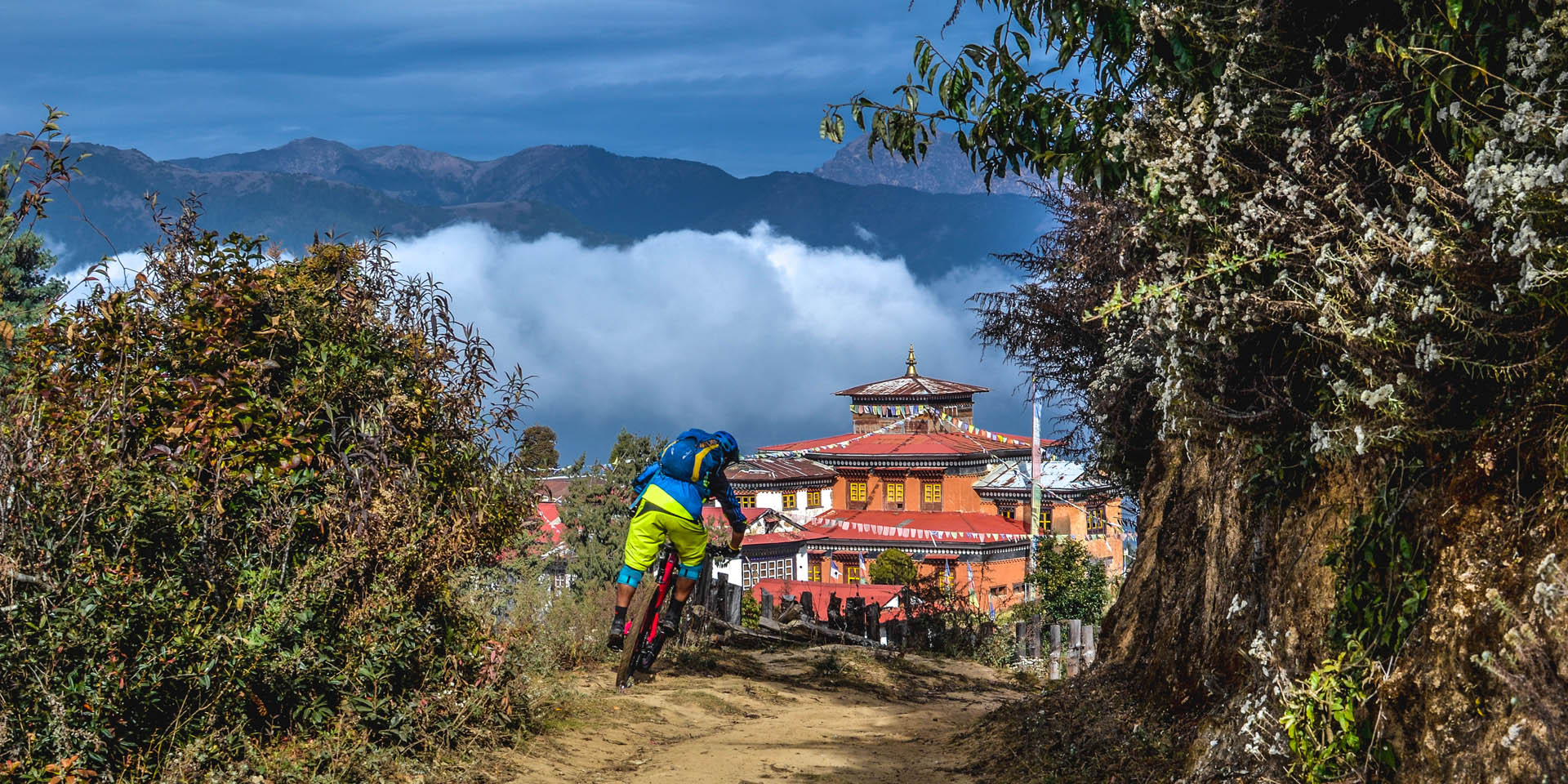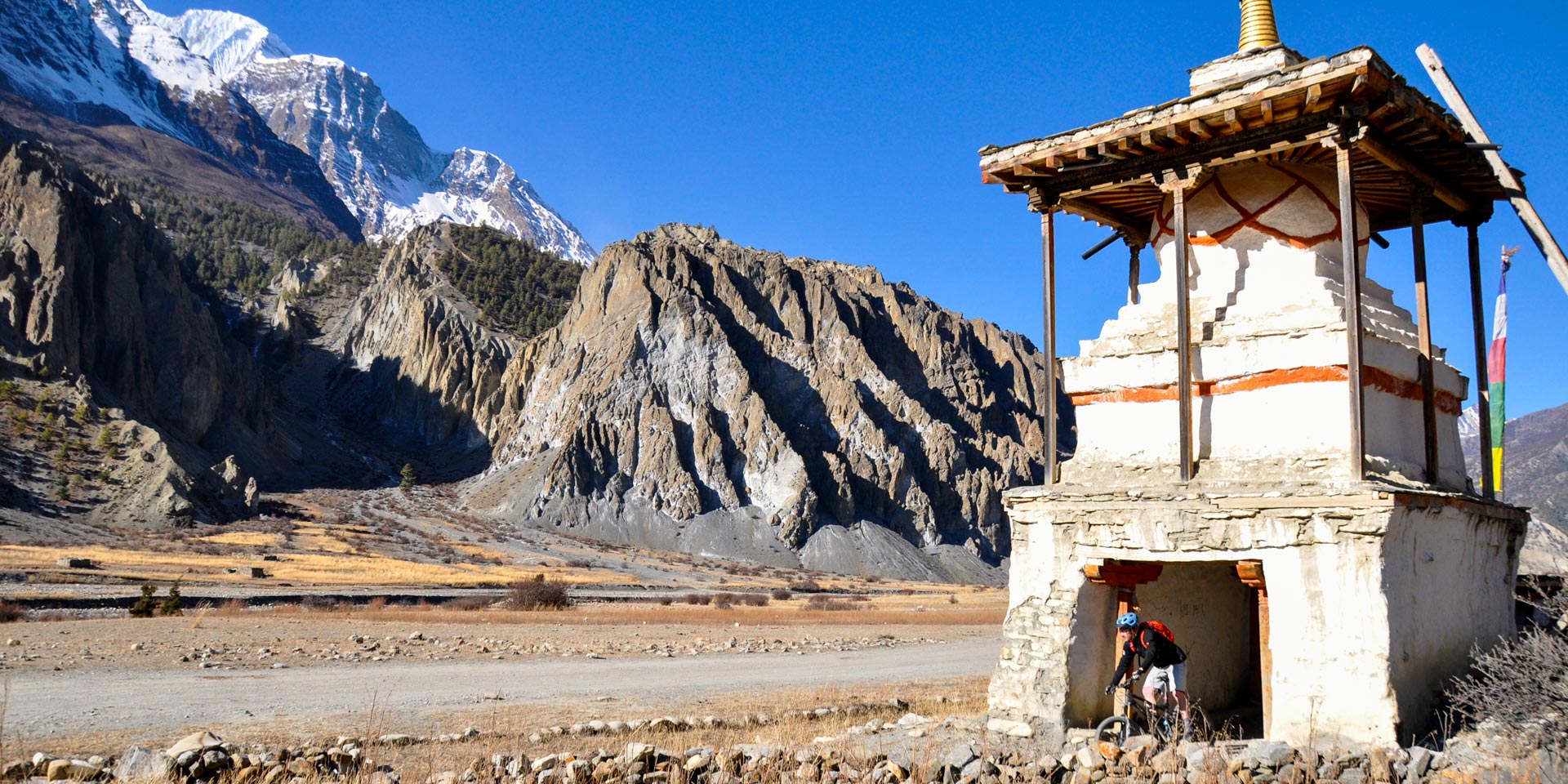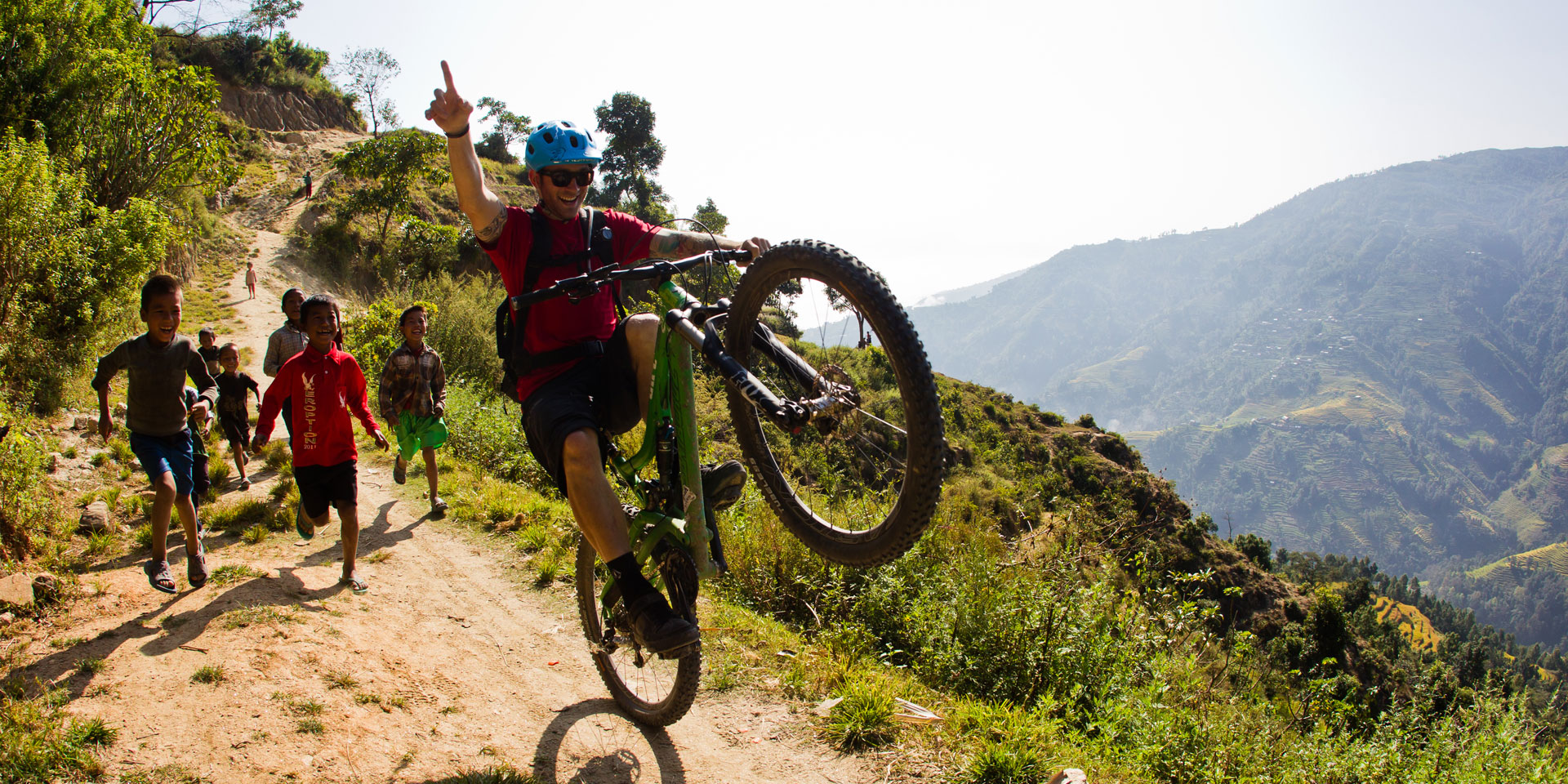General Packing Theory
Mountain biking trips in Nepal have varied accommodations, depending on the area. Some are hotel stays; some are in town and have all the facilities and some are basic ‘tea house’ style with shared bathrooms and basic rooms. Check out our blog post on tea houses.
All personal and group gear travels either with the jeeps and truck during the day or with porters who carry it. Luggage meets us at our lodging at the end of the day. Let us know if you would like to know the specifics about luggage transport or back-up vehicles on your trip.
One bag to pack all your personal gear in is ideal. We recommend a big duffel bag and what you need during the day goes in your backpack that you’ll be carrying. Though we want you to travel comfortably, try to pack within reason – there is limited space in the van and if your trip has porters, the luggage limit is 15kg per person.
The following list shows what we recommend you bring for your comfort. You may decide on some changes on the list to suit your personal needs. Please get in touch with us if you have any questions about what you should bring or what suitable alternatives might be.

The Gear List
Passport and plane tickets!
Sleeping bag Depends on the time of year, but down-filled bags are the best to bring. Beg, borrow or steal a good one (i.e. 3-4 season) because the nights can be cool, and there is nothing worse than to be cold at night. If it’s winter and you have a 3-4 season bag then you can get a fleece sleeping bag liner in Kathmandu, they are good and reasonably priced. Quite good sleeping bags are available for inexpensive rent (or buy) in Kathmandu, in which case you will also want a sleeping bag liner.
Sleeping bag liner Cotton, silk or fleece. Saves washing your sleeping bag all the time and adds warmth. Cotton or silk ones can be bought in Kathmandu at a more favourable price than from home. Fleece ones are readily available in Kathmandu and will cost you next to nothing.
Daypack It needs to be big enough to take a jacket, water, sunscreen, camera, valuables and odds and ends. You pack your daypack in the morning and the rest of your baggage goes in the truck. You should have everything you need through the day with you, however we can always leave a few things in the support jeep also.
Helmet You have to wear a helmet to join the riding on this trip! Helmets can save lives and that is enough for us to not let you ride without one. We recommend that you bring your own from home.
Cycle shorts and tights Padded cycle shorts are a must and padded long tights if it’s cold; at least you should bring your padded cycle shorts, with some loose shorts or 3⁄4 trousers for over the top (no one in Nepal wants to see you in your lycra, especially for days when you will visit temples!)
Cap A cap gives a lot of protection from the sun. A bandana or stretchy ‘buff’ can also be used to shade your neck.
Socks Your feet will be warm or even hot while cycling so quality cotton mix sports socks are best. Three to four pairs are enough. Thick socks are better for higher up and cool evenings and you can just bring one or two pairs for evening use.
Shoes You will need shoes for the rest time and for bicycling. We recommend bringing two pairs. One pair for walking around town/hotel time (a pair of sandals, crocs or lightweight sneakers are recommended), and one pair of bike shoes.
Fleece top Most people consider this essential, but alternatives are a thick thermal top or a light down jacket, depending on which area you’re going into. The evenings can get quite cold and you might even consider bringing a down jacket (you can also rent (or buy) good ones in Kathmandu; they are also very reasonably priced to buy here). Please check with us if you’re not sure of the temperatures to expect and exactly what cold-weather gear you might need.
Wind/rain jacket Waterproof and breathable. Plastic ponchos or non-breathable raincoats are not suitable.
Thermal underwear top and bottom Good thermals are one of the secrets to cold weather comfort. Expedition-weight thermals are the most versatile and can be worn to bed at night if it gets really cold and for very cold areas.
Day wear shirt T-shirts are popular but a cotton shirt or mixed yarn travel shirt is more useful. The collar protects the back of your neck and the sleeves can be rolled up or down. Take at least two so you can swap damp for dry.
Sunglasses We are going to have a lot of sun, a good pair of sun glasses that fit well with your helmet is essential.
Cycle gloves/Gloves Bring your cycle gloves to protect your hands.
Water bottles Should be one litre or more in capacity. You want a total of 2 litres capacity, including a hydration bladder system if that’s what you prefer. Don’t forget to bring a backup bottle if you’re using a bladder.
Bags Garbage bag and ziplocs are handy for convenient storage. Waterproof bags are great for keeping your dirty laundry separate from your clean gear!
Head Torch Power outages are common in Nepal so a torch is essential! Head torches are more convenient than hand held ones, especially if you need to balance on the loo during the night.
Toiletries and odds and ends Essentials for the trip only. The smallest tube of toothpaste. Bring toilet paper. Roll-on deodorant can spare you grief with your room partner... Biodegradable soap and shampoo - small containers are recommended.
Hand sanitiser Good hand hygiene is imperative for your whole trip in Nepal! If soap and water isn’t available at the bathrooms or meal times, use your hand sanitiser! A small bottle clipped to the outside of your bag makes this easy.
Towel In Nepal the hotels supply towels, but the tea houses don’t, so it’s a good idea to bring a small travel towel.
Sun screen and lip care with sun protection The sun can be strong.
Moisturiser The air can be dry and the sun harsh.
First aid kit We carry one with aspirin, paracetamol, various antibiotics for Nepalese varieties of diarrhoea, antiseptic, antihistamine cream, bandages, and tough blister tape (but not moleskin). You MUST bring any personal medicines that you require and carry them with you.
Water purification You will receive filtered water while you’re on the trail (we use Katadyn filters) and you may also want to consider bringing your own water purification device/drops/tablets as a backup. If you have one, certainly bring it along. If it’s something you would use again in the future, you may want to consider getting something like a Steripen, straw/bottle device or stand-alone filter.
Over recent years transitioned our trips from boiled water to filtered water. This was such a win-win situation for the environment that we couldn’t not! We do still recommend that you have at least one water bottle that can take boiling/hot water, which is available for purchase at the tea houses. Due to the resources that it takes to create the hot water (ie, wood from the forest or gas that’s carried in by foot), please keep this as a treat for when you really need it.
Camera Nepal is particularly photogenic. No matter whether you’re a professional photographer, you’re Insta famous or just collect some images for the memories, it’s best to bring everything you require from home.
Book One or two with high swap-ability. Kathmandu has some great second-hand bookshops. You will also find a very big variety in Himalayan titles in the bookshops here, we recommend Pilgrims bookshop in Thamel and Mandala Book Point on Kantipath.
Money pouch/belt/inside pocket Most people find wearing one while biking a hassle and keep it buried in their daypack. Most city hotels have safety deposit boxes.
Snacks and nutrition You will feel your best with plenty of good food and keeping hydrated. We provide the meals and the water. The last two ingredients are wholesome snacks and vitamin tablets. Biscuits and chocolate bars are readily available on the trails. Bring vitamin tablets and sports bars from home. For those interested in supporting our local entrepreneurs, there’s a great local brand of granola bars called Snack On, available in supermarkets around Kathmandu: snackonbars.com
Tools and Spares Bring bicycle parts specific to your bike. You know your bike better than we do. Though we carry a complete set of tools for repair, there can always be something unusual that could create a problem. Please reach out if you have any questions. We recommend that you bring your own spare tubes and small pump to be independent while on the trail. Please also bring your own pump for air suspension type shocks.
The most likely problems on any of our trips are punctures and bent spokes. If you have any questions about gear, please do not hesitate to ask us for advice.
Tools and spares that everyone should bring:
- Pump / Puncture Repair Kits and plugs
- Plastic tyre levers / Allen keys
- Chain link extractor / Spoke key
- Oil can / Multiple bike spanner
- Tube of grease / 1 inner tube
- 1 rear brake cable / 1 rear gear cable
- Brake blocks / 3 spare spokes
- Suspension pump

ITEMS TO KEEP IN YOUR DAY PACK WHILE BIKING
- Water Bottle plus camelbak
- Mid-weight sweater/fleece
- Water proof layer
- Hat
- Camera
- Sunglasses
- Sunscreen
- Pump and tubes and any specific tools/spares (see tools and spares list)
- Snacks
- Money and valuables
OTHER THINGS TO KNOW
The trails
Riding trails in Nepal vary from wide, road-like avenues to narrow, slippery paths built out over enormous drops. In some places, a fall from the trail would be fatal. One must pay attention at all times and never ride beyond your limits. Your guide is there to prepare you for the trails ahead and there’s ALWAYS time for you to stop and walk any features that you’re not comfortable riding.
In Kathmandu you’ll encounter busy streets with traffic buzzing around you. Leave behind any rules you know from home because they probably won’t work here! It’s important to keep your eyes all around you, make eye contact with drivers and motorbike riders and be as predictable as possible. It’s easier said than done, but don’t worry, your guide is really there to help with everything, even crossing the street!
How much is enough or too much?
Pack for your personal needs. It is difficult for us to advise you of exact quantities (i.e. 2 shorts, 3 shirts, etc.), as everyone has different needs. However, our guests are usually amazed at how much they can do without and comment that they could have left some of their gear at home. Due to space limitations, please don’t pack the unnecessary items. Remember, you will have to pack it up every day and then unpack it and in some cases you have a person carrying gear for 2 people.
Medications
Any medications you need during the day must be carried in your daypack or in a pocket so you have them with you when you need them.
What To Wear When
For cultural reasons, outside of the cities we request you not to wear tight pants or short shorts. If you want to wear shorts, please make them loose fitting and long (approaching the knee). You’ll of course see a little of everything while you’re here, but the most respectful thing is to dress a little more conservatively than in other places.
While riding, we don’t recommend getting around in your lycra unless you have something baggy over the top – wearing tight clothing and clothing that shows your shoulders and legs above the knees is not polite in Nepal.
Avoid spaghetti strap singlets, having a cap sleeve is best.
What Is Available In Kathmandu
Most of all of this gear is available in Kathmandu, we now even have the originals of the major brands, even if they ARE selling last season’s gear (at great prices)! There are also some very good gear shops that sell good mountain products under their own brands at a much more reasonable price. You can ask your guide for tips on where to go for good gear if you want to pick it up in Kathmandu (doing this on arrival day is best). The items that are better brought from home are: socks, boots, thermals, gloves, Gore-tex clothing and anything that you know you can’t go without.
Renting Equipment Easy to rent items in Kathmandu are down jackets and sleeping bags.
Some of the items available in Kathmandu are of differing quality so shop around or ask us to point you in the right direction:
- Sleeping bag and liner
- Warm hat
- Cap
- Fleece top
- Warm gloves
- Toilet paper
- 1 litre water bottle (watch out for fake Nalgene bottles that aren’t necessarily BPA free)
- Books
- Lip care
- Sunscreen
- Torch
- Moisturiser
- Rain/wind jacket
- Water purification tablets
- Camp shoes
Bring from home
- Cycling/SPD shoes
- Cycle shorts/tights
- Socks
- Helmet
- Daypack/Camel bag
- Cycle gloves
- Underwear
- Sunglasses
- Toiletries and odds and ends
- Personal medicines
- Camera
- US dollars for visa on arrival (for day to day, you will need Nepali Rupees, not Dollars)
- Vitamin tablets
- Thermal top
- Day wear shirt x2 or 3
Tipping and cash requirements
While most main meals are provided while in the mountains, do not forget to bring some Nepalese rupees for drinks or snacks that you might purchase on the way, showers and device charging. You will be surprised by what is available on the popular routes now! Around Rs2000 per person per day usually covers your extras, but the amount to carry depends on the area you are going to, so please ask your guide for advice.
The easiest way to get local currency is from the ATMs in Kathmandu and other cities, exchanges booths will also exchange major currencies for you.
Tipping is now common in Nepal but there is no strict rules about how much the tip should be. You should only tip if you are satisfied with the service.
Toilets
Wherever you use a western or squat style toilet be sure to place your toilet paper in the rubbish bin provided – do not flush it down the toilet as this may block the sewer system. You may also want to carry your own toilet paper as not all public toilets or tea houses will supply it and many don’t have soap either, so a gel sanitiser/small soap is a good thing for your day pack.
Some tips for staying healthy
- Do NOT drink or brush your teeth with tap water or untreated water!
- Drink only filtered water or use water purification tablets, such as iodine. Bottled water is available, but as the plastic cannot be recycled in Nepal we request you to consider the waste impact of your bottles – we recommend you drink filtered water or use iodine.
- Your hands are perhaps your biggest enemy in terms of your health as they get very dirty during the day. Wash your hands before every meal or snack. People often think they get sick from the food, but it’s far more likely they forgot to wash their hands!
- DO NOT try to test your fitness and go too high, too quickly! Listen to your guide and take their advice as they are trained to look after your safety. Altitude sickness is a killer and you MUST take it seriously.
Security and Personal Safety
While security and theft is rarely an issue in Nepal, always exercise caution as the consequences can be a holiday-ending!
- Keep valuables secure and don’t display expensive equipment unnecessarily
- Don’t leave valuables in an unlocked tea house room (or anywhere that they’re not secure)
- While on the trail, keep money, credit cards, passports, all electronic devices and anything else of value in your day pack (don’t put them in your main luggage)
Ask your guide! The team is here to help you with every situation you may face so if you’re not sure about something you’re seeing or thinking, your guide will be happy to give some insight
Most trevellers have wonderful, safe experiences in Nepal by taking reasonable precautions and respecting the mountain environment.
Photographing people
During your time in Nepal you will have many opportunities to photograph local people and the amazing scenery and you will use tons of memory space! When you want to take a photo of a person, please ask them first and respect their right to refuse – you will be surprised how easy it is to convey the request to take someone’s photo even when you don’t share a common language! If you have a digital camera or phone it is considerate (and fun!) to show them their photo and if it’s possible to arrange to have copies printed and sent to them this is an amazing gift! However, do not promise to do so if you are not sure you can deliver on the promise, so please talk to your guide about this! Photos can be a brilliant way to establish a connection with local people, but please respect their right to privacy.
Considering the Environment
While in the Himalayan region you have to be careful not to destroy the very environment you are enjoying so much. It is not only for your enjoyment, people and wildlife rely on this environment for their drinking water and food supply and many places are of enormous religious significance to local people.
There are many ways you can help to conserve the environment of the area you’re visiting. Here are some simple tips:
- pick up any litter along the trail;
- burn all your toilet paper and bury your faeces when not in camp, make sure you go at least 50m away from any water source;
- do not make campfire, nor consume food cooked on wood fires;
- drink treated water instead of mineral water as the plastic bottles are a problem and even better, drink filtered water;
- stick to the trails to prevent erosion and damage to fragile alpine flora;
- ensure all rubbish is packed out (or burnt/buried if appropriate).
Insurance
All tour participants should obtain their own personal insurance which covers medical and emergency evacuation at a minimum. You will of course also want cover for loss or damage to personal effects, flight or trip cancellation etc.
Final tips!
To ensure that you have the best time possible and that Nepal benefits from your visit, please respect local traditions, customs, values and the environment. You will have a great time if you are open to the warm hearted Nepali hospitality and if you respect their efforts to protect their local culture and maintain local pride.
- Respect privacy when taking photographs
- Respect holy places and dress appropriately
- Refrain from giving money or food to children. There are many good organisations working to help street children, we recommend you support them instead of encouraging the kids to stay on the street.
- Your attempts at speaking some Nepali will open hearts and bring huge smiles!
- Protect the natural environment, see above
- Finally, respect local ways. You may not agree with everything you see and you may want to intervene or say something. Please remember, you probably do not fully understand what you are seeing and in any case your role here on your holiday is not to change Nepal. If you feel strongly about it then that’s great… there are many avenues for volunteering or long term work here to support positive, sustainable change for Nepal!



